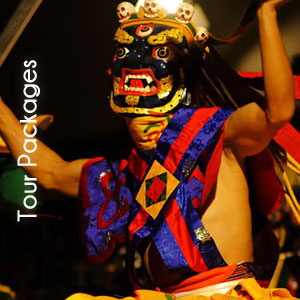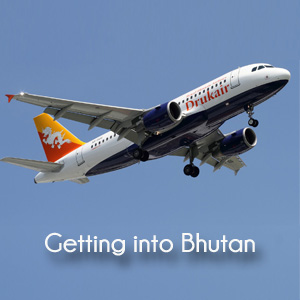The Paro tsechu in spring is a major attraction in Paro district. People come from neighbouring districts to participate in the festivity. On the final day, the best time to go is early in the morning as the monks of the Paro Dzong prepare to display a giant appliqué thangkha, the Guru Throngdel, inside the dzong.
Paro festival is one of the most popular festivals in the country and amongst the tourist. Offers the best opportunity to witness the Bhutanese’s rich culture, history and religion that distinguish the people and country distinctly from rest of the countries. Bring you a closer contact with the people and give you an insight into the Bhutanese lives, beliefs and more. During Tshechu the dances are performed by monks as well as by laymen. The Tshechu is a religious festival and by attending it, it is believed one gains merits. It is also a yearly social gathering where the people come together to rejoice dressed in all their finery.
Day 1: (inside the dzong)
Dance of the Lord of Death and his Consort (Shinje Yab Yum)
Bodhisattva Manjusri – representing the wisdom of all Buddhas – takes on the appearance of the terrifying Lord of Death (Shinje). His wrathful buffalo face guards the four continents.
Dance of the Lords of the Cremation Grounds (Durdag)
A dance that takes place in cremation grounds. The dancers wear skull masks and represent protectors of the religion who live in the eight cremation grounds on the periphery of the symbolic Mt. Sumeru.
The Black Hat Dance (Shanag)
The black hat dancers assume the role of yogis with the power to subdue and create life. The dancers wear brocade robes, wide brimmed black hats and aprons with the face of a protective deity. This is an important dance that is also used in purification ceremonies during the construction of dzongs, temples, chortens.
Dance of the Drum from Dramitse (Dramitse Ngacham)
A dance inspired in meditation. The dance is a vision of Guru Rinpoche and his celestial palace, Zangdopelri. Here, Guru’s attendants are transformed into hundreds of peaceful and terrifying deities. The dance originated in Dramitse Monastery in eastern Bhutan and is considered a Bhutanese heritage.
Dance of the Eight Kinds of Spirits (Degye)
A dance of the gods of the three worlds (sky, earth, underground). The gods protect the doctrines of the Buddha and subdue the spirits who make the world unhappy. Endless happiness is recovered. The dance is performed by the gods (believed to be incarnated in the dancers themselves) to renew faith and wisdom.
Religious song (Chhoeshay)
This commemorates the opening of the gateway to the pilgrimage site of Tsari in eastern Tibet by the founder of the Drukpa School of Buddhism, Tsangpa Jarey.
Day 2: (outside the dzong)
Dance of the Lord of Death and his Consort (Shinje Yab Yum)
Bodhisattva Manjusri – representing the wisdom of all Buddhas – takes on the appearance of the terrifying Lord of Death (Shinje). His wrathful buffalo face guards the four continents.
Dance of the Black Hats with drums (Shanag Nga Cham)
A dance to signify the victory of religion over enemies. The sound of the drum represents religion itself.
Dance of the Three Kinds of Ging with sticks (Gingsum)
A dance signifying the subjugation of demons that are obstacles to religions. It takes place in Zangtopelri, the heavenly palace of Guru Rinpoche.
Dance of the Lords of the Cremation Grounds (Durdag)
A dance that takes place in cremation grounds. The dancers wear skull masks and represent protectors of the religion who live in the eight cremation grounds on the periphery of the symbolic Mt. Sumeru.
Dance of the Three Kinds of Ging with drums (Driging)
After the demons are vanquished, the gings with the drums dance with happiness. They beat the drums of religion and the dance is performed to bring good luck to all beings and to wish them happiness. This dance brings blessings to all who watch it.
Dance of the Stag and the Hounds (Shawa Shachi) – 1st part
The dance tells a favourite tale of Milerepa who converts a hunter to Buddhism.
Day 3: Dance of the Lords of the Cremation Grounds (Durdag)
A dance that takes place in cremation grounds. The dancers wear skull masks and represent protectors of the religion who live in the eight cremation grounds on the periphery of the symbolic Mt. Sumeru.
Dance of the Terrifying Deities (Tungam)
Dressed in beautiful brocade and terrifying masks, this is a deeply symbolic dance where a sacrificial murder is performed. Guru Rinpoche appears in a wrathful manifestation to save the world. The dance is meant to show all beings the way to salvation.
Dance of the Heroes with six kinds of ornaments (Guan Drug Pawo)
The heroes hold six ornaments – five rings of bone ornaments and a small drum and bell in their hands. By their gestures and the sound of their melodies, the heroes lead sentient beings from the wheel of reincarnation along the path of liberation.
Kyecham is an accompanying dance to the next dance. The kyecham dancers wear knee-length yellow skirts, and animal masks.
Dance of the Noblemen and Ladies (Pholeg Moleg)
A comical play that depicts the life of King Norzang. The play is full of bawdy and rustic humour as two princes and two princesses, and old couple and clowns enact a story of misbehaviour, deceit, and mistrust. The story ends happily with the princes marrying the princesses and reconciliation takes place as a lesson to life.
Dance of the Stag and the Hounds – 2nd part
This is a conclusion of the dance began on the second day. The saint Milarepa appears in a long white dress and converts the dogs, stag and the hunter with a song. The conversion is symbolised by the hunter and his dogs jumping a rope.
Day 4:
Dance of the Lord of Death and his Consort (Shinje Yab Yum)
Bodhisattva Manjusri – representing the wisdom of all Buddhas – takes on the appearance of the terrifying Lord of Death (Shinje). His wrathful buffalo face guards the four continents.
Dance of the Four Stags (Sha Tsam)
A dance that depicts Guru Rinpoche subduing the God of Wind who is believed to have created unhappiness on earth. Dancers dress as stags in yellow knee length dress and masks of the deer. The stag represents the mount of the God.
Dance of the Judgement of the Dead (Raksha Mangcham)
This dance is based on the Bardo (Book of the Dead). When beings die they wander in an intermediate state known as the bardo. They cross the bardo to meet their judgement by the Lord of Death. Also present is the white god and black demon who have been with every being from birth. The dance is like a play which depicts the judgement of a sinner and a virtuous man who goes to heaven. The rakshas are the helpers of the Lord of Death.
Dance of the Drums from Dramitse (Dramitse Nga Cham)
A dance inspired in meditation. The dance is a vision of Guru Rinpoche and his celestial palace, Zangdopelri. Here, Guru’s attendants are transformed into hundreds of peaceful and terrifying deities. The dance originated in Dramitse Monastery in eastern Bhutan and is considered a Bhutanese heritage.
Day 5:
The great thangkha (thongdrel) is shown early in the morning followed by the Shugdrel ceremony.
Dance of the Heroes (Pacham)
A dance to lead believers in the human world into the presence of Guru Rinpoche.
Dance of the Ging and Tsholing
Guru Rinpoche initiated this dance during the consecration of the ancient Samye Monastery in Tibet. The dance is a purification ceremony. People whistle to chase away bad spirits. The ging, dressed in orange skirts and a terrifying mask, use their drumsticks to hit everyone on the head to drive out impurity. The tsolingrepresent protectors of the religion and are dressed in long colourful dresses and terrifying masks.
Dance of the Eight Manifestations of Guru Rinpoche (Guru Tshen Gye)
This dance is one of the highlights for Buddhist practitioners. The Guru appears in eight different forms in a dance that is also a play.
Dance of the Sixteen Fairies
After all eight manifestations appear, 16 fairies sing and perform two dances in front of the Guru. The fairies are Goddesses of Offerings who perform a dance to bring happiness. They are dressed in brocade dresses with carved bone ornaments. After these final songs, the manifestations go out in a long procession.
Religious Song (Chhoeshay)
This commemorates the opening of the gateway to the pilgrimage site of Tsari in eastern Tibet by the founder of the Drukpa School of Buddhism, Tsangpa Jarey.

Bhutan Travel Info
Bhutan Travel tips, Daily Tourist Tariff, Bhutan Visa Information, Tour payment regarding your tour booking to Bhutan. Click on the link below to know more.
Learn more >>

Tour Packages
Travel to Bhutan with Sachock Bhutan Travels. We, at Sachock offers Cultural tours, Trekking Tours including the World's toughest Trek Snowmen Trek and colorful Festival tours of Bhutan.
Learn more >>

Getting into Bhutan
Travelling to Bhutan can be accessible by Air, to Paro(the only international airport in Bhutan connecting with Indian Cities, Nepal, Bangaldesh, Thailand & Singapore) & Road through Southern border towns of Phuentsholing, Gelephug and Samdrup Jongkhar.
Learn more >>

Sachock Bhutan Travels, P.O Box No: 1304, Karma Khangzang, Thimphu : Bhutan
Phone # (+975) 77177717 / 77210443 : Tele-Fax (+975) 2 333 881
Email: [email protected] / www.SachockBhutanTravels.com
Sachock Bhutan Travels, Copyright © 2025. All Rights Reserved.






